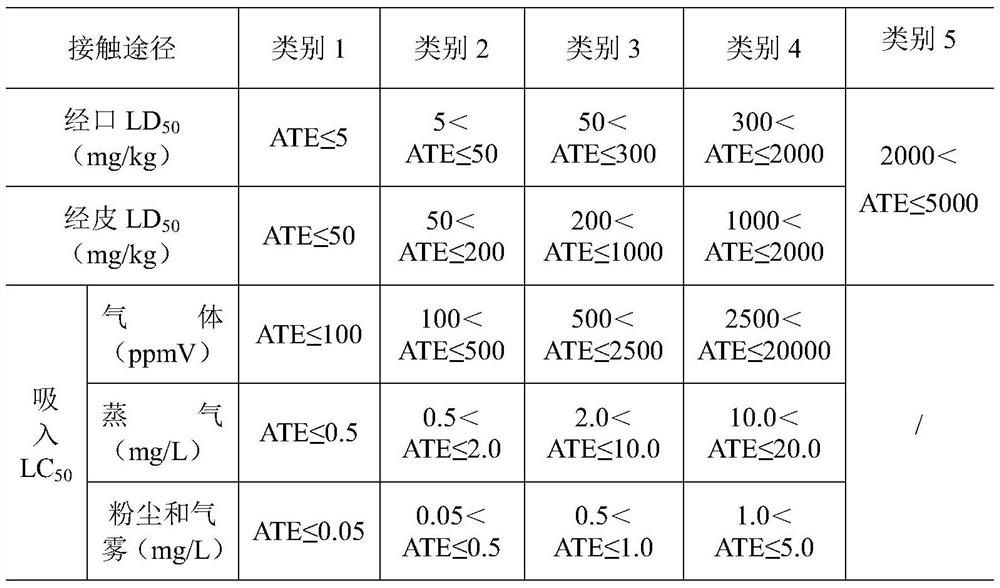Method for judging acute inhalation toxicity of acute inhalation toxicity mixture in different states
A technology for inhalation toxicity and determination method, applied in the field of hazardous chemicals, can solve the problem of difficult data acquisition and achieve the effect of protecting animal welfare
- Summary
- Abstract
- Description
- Claims
- Application Information
AI Technical Summary
Problems solved by technology
Method used
Image
Examples
Embodiment 1
[0052] A chemical A, containing 1.9% nicotine, 6% diacetyl, 65% propylene glycol, and 27.1% glycerol, the acute toxicity of the contained chemicals is shown in Table 2 below:
[0053] Table 2
[0054]
[0055] According to the queried acute inhalation toxicity data, nicotine and diacetyl have acute inhalation toxicity, of which nicotine is the most harmful and is classified as acute toxicity-inhalation category 2. Since the acute inhalation toxicity data queried for diacetyl is an interval range, from From the perspective of strict classification, the acute toxicity data of diacetyl in the following acute calculation is 2.25mg / L.
[0056] The overall acute inhalation toxicity of this chemical A cannot be classified as Category 1, so the calculation starts with the classification of Category 2:
[0057] Category 2:
[0058] Since the nicotine and diacetyl acute toxicity data queried are values in aerosol and vapor state respectively, the upper limit of classification cor...
Embodiment 2
[0068] A chemical B, containing dioctadecyl dimethyl ammonium chloride 25%, butyl glycol ether 6%, furfural 5%, glutaraldehyde 3%, water 61%, the acute toxicity of the contained chemical substances is detailed See Table 3 below:
[0069] table 3
[0070]
[0071] The acute inhalation toxicity value of ethylene glycol butyl ether is found to be 450ppm, which is less than 90% of its saturated vapor pressure of 1158ppm, so it is considered that 450ppm is the test data in the gas state. Dioctadecyl dimethyl ammonium chloride exceeds the classification critical value according to the queried data, it is considered that it does not have inhalation toxicity, and it is not considered in the classification calculation.
[0072] According to the acute inhalation toxicity data inquired, butyl glycol ether, furfural and glutaraldehyde have acute inhalation toxicity, all of which are acute toxicity inhalation category 2. Therefore, the acute inhalation toxicity of the overall mixture d...
Embodiment 3
[0083] A certain chemical C, containing isophorone diisocyanate 15%, ethylene glycol butyl ether 10%, urethane modified isocyanate 30%, ethyl acetate 45%, the acute toxicity of the contained chemicals is shown in Table 4 :
[0084] Table 4
[0085]
[0086] The acute inhalation toxicity value of ethylene glycol butyl ether is found to be 450ppm, which is less than 90% of its saturated vapor pressure of 1158ppm, so it is considered that 450ppm is the test data in the gas state. According to the acute inhalation toxicity data inquired, the acute inhalation toxicity of isophorone diisocyanate and ethylene glycol butyl ether is acute toxicity inhalation category 2, and the acute inhalation toxicity of ethyl acetate is category 4. Therefore, the acute inhalation toxicity of the overall mixture is Toxicity does not consider category 1, but starts from category 2:
[0087] Since the acute inhalation toxicity data of isophorone diisocyanate, ethylene glycol butyl ether and ethyl ac...
PUM
 Login to View More
Login to View More Abstract
Description
Claims
Application Information
 Login to View More
Login to View More - R&D
- Intellectual Property
- Life Sciences
- Materials
- Tech Scout
- Unparalleled Data Quality
- Higher Quality Content
- 60% Fewer Hallucinations
Browse by: Latest US Patents, China's latest patents, Technical Efficacy Thesaurus, Application Domain, Technology Topic, Popular Technical Reports.
© 2025 PatSnap. All rights reserved.Legal|Privacy policy|Modern Slavery Act Transparency Statement|Sitemap|About US| Contact US: help@patsnap.com



